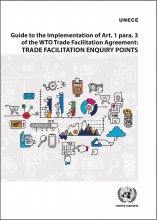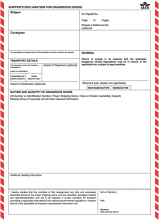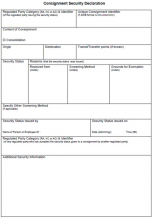Data mapping between selected business documents used in multimodal data and document exchange and regulatory information systems, such as Single Window and Customs systems
During this consultancy project, the Consultant analyzed the data requirements in a sample transport document aligned to the UN/CEFACT Multimodal Transport Reference Data Model (MMT RDM), the European Union Customs Data Model (EUCDM) and the WCO Data Model. The objective was to produce data mapping between these instruments, with a view to propose practical solution for using in regulatory information systems (such as regulatory Single Window, Customs systems) the information in the package of standards for the digitalization of multimodal transport data and document exchange.
UNTTC Training course on UN/CEFACT Standards
The UNTTC Training course on UN/CEFACT Standards was developed as part of the United Nations response to the challenges of the COVID-19 pandemic under the United Nations multiagency project “Transport and Trade Connectivity in the Age of Pandemics: UN solutions for contactless, seamless and collaborative transport and trade”.
How to develop real world electronic document equivalents using UN/CEFACT standards and reference data models
The digitalization of the supply chain is the dominant trend in international trade and transport at present and the main tool for facilitating trade procedures. Due to the essence of the supply chain as a process of interaction between many parties within many jurisdictions, ensuring interoperability plays a key role both in the supply chain and in the digitalization processes. In this regard, the development, maintenance and adoption of standards at the international level play an extremely important role. This explains the continued focus on standardization in trade and transport facilitation by UN institutions: notably, the United Nations Economic Commission for Europe (UNECE) and the United Nations Centre for Trade Facilitation and Electronic Business (UN/CEFACT).

(EN&RU) Guide to the Implementation of Art. 1 para. 3 of the WTO Trade Facilitation Agreement: Trade Facilitation Enquiry Points
The World Trade Organization (WTO) Trade Facilitation Agreement (TFA) entered into force on 22 February 2017. The United Nations Centre for Trade Facilitation and Electronic Business (UN/CEFACT) defines trade facilitation as “the simplification, harmonization and standardization of the procedures and associated information flows required to move goods and provide related services from seller to buyer such as payments”1. Trade facilitation can help simplify, standardize, harmonize, and modernize international cross-border trade, thereby increasing trade volumes and making international trade faster and cheaper, as well as more accessible for small and medium-sized enterprises (SMEs) and landlocked developing countries. Trade and trade facilitation have the potential to contribute to resilient, inclusive and sustainable recovery after the pandemic.
According to Art.1 of the TFA, WTO members shall promptly publish information related to international trade to enable WTO members (and all interested parties, accordingly) to acquaint each other with their trade rules and ensure transparent and predictable conditions of international trade. WTO members are also encouraged to make available further trade-related information on the Internet and to establish or maintain enquiry points. In compliance with TFA Art. 1.3 these enquiry points should provide the necessary information.

How to develop real world electronic document equivalents using UN/CEFACT standards and reference data models
The digitalization of the supply chain is the dominant trend in international trade and transport at present and the main tool for facilitating trade procedures. Due to the essence of the supply chain as a process of interaction between many parties within many jurisdictions, ensuring interoperability plays a key role both in the supply chain and in the digitalization processes. In this regard, the development, maintenance and adoption of standards at the international level play an extremely important role. This explains the continued focus on standardization in trade and transport facilitation by UN institutions: notably, the United Nations Economic Commission for Europe (UNECE) and the United Nations Centre for Trade Facilitation and Electronic Business (UN/CEFACT).
Air Way Bill Standard Package
The Air Way Bill Standard Package was developed as part of the United Nations response to the challenges of the COVID-19 pandemic under the United Nations multiagency project “Transport and Trade Connectivity in the Age of Pandemics: UN solutions for contactless, seamless and collaborative transport and trade” in cooperation with ICAO.
This electronic document equivalent Standard Package consists of the following elements:

Air Dangerous Goods Declaration
The Air Dangerous Goods Declaration Standard Package was developed as part of the United Nations response to the challenges of the COVID-19 pandemic under the United Nations multiagency project “Transport and Trade Connectivity in the Age of Pandemics: UN solutions for contactless, seamless and collaborative transport and trade” in cooperation with ICAO.
This electronic document equivalent Standard Package consists of the following elements:

Air Consignment Security Declaration
The Air Consignment Security Declaration Standard Package was developed as part of the United Nations response to the challenges of the COVID-19 pandemic under the United Nations multiagency project “Transport and Trade Connectivity in the Age of Pandemics: UN solutions for contactless, seamless and collaborative transport and trade” in cooperation with ICAO.
This electronic document equivalent Standard Package consists of the following elements: